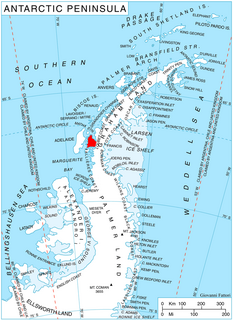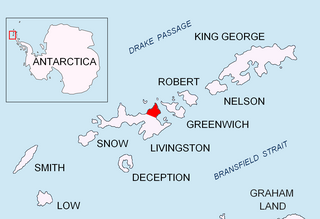Related Research Articles

Arrowsmith Peninsula is a cape about 40 miles (64 km) long on the west coast of Graham Land, west of Forel Glacier, Sharp Glacier and Lallemand Fjord, and northwest of Bourgeois Fjord, with Hanusse Bay lying to the northwest. It was surveyed by the Falkland Islands Dependencies Survey (FIDS) in 1955-58 and named for Edwin Porter Arrowsmith, Governor of the Falkland Islands.

Blaiklock Island is a high and rugged, irregular-shaped island 17 kilometres (9 nmi) long, lying between Bigourdan Fjord and Bourgeois Fjord. It is separated from Pourquoi Pas Island by The Narrows and from the west coast of Graham Land by Jones Channel. The feature was partially surveyed in 1936 by the British Graham Land Expedition under Rymill, at which time it was charted as a promontory. It was determined to be an island in 1949 by Kenneth V. Blaiklock, a Falkland Islands Dependencies Survey (FIDS) surveyor for whom it is named.
Irving Island is a small island at the northeastern end of the Barcroft Islands, in the Biscoe Islands, Antarctica. It is situated 1.18 km east of St. Brigid Island and 1.9 km north of St. Isidore Island. The island was mapped from air photos taken by the Falkland Islands and Dependencies Aerial Survey Expedition (1956–57), and was named by the UK Antarctic Place-Names Committee for Laurence Irving, an American physiologist who has specialized in the effects of a polar environment.
Bedford Island is an island about 1 nautical mile (2 km) long, lying at the south end of the Barcroft Islands in the Biscoe Islands, 700 m south of Chakarov Island. It was mapped from air photos taken by the Falkland Islands and Dependencies Aerial Survey Expedition (1956–57), and named by the UK Antarctic Place-Names Committee for Thomas Bedford, an English physicist who specialized in the measurement of the physical environment of man.
Belding Island is an island 3 nautical miles (6 km) long, lying west of the south end of Watkins Island, Biscoe Islands. It was mapped from air photos taken by the Falkland Islands and Dependencies Aerial Survey Expedition (1956–57), and named by the UK Antarctic Place-Names Committee for Harwood S. Belding, an American physiologist who was Director of the Quartermaster at the Climatic Research Laboratory, Department of the Army, Lawrence, Massachusetts, and initiated considerable research on cold climate clothing.

Mount Deeley is a mountain 2,150 metres (7,050 ft) high, on Pernik Peninsula, Loubet Coast in Graham Land, standing 6 nautical miles (11 km) northeast of Salmon Cove. It was mapped from air photos taken by the Falkland Islands and Dependencies Aerial Survey Expedition of 1956–57, and it was named by the UK Antarctic Place-Names Committee for Richard M. Deeley, a British geologist who made important investigations of the structure and flow of glaciers.

Krogh Island is an ice-covered island about 5 nautical miles (9 km) long lying close west of the southern part of Lavoisier Island in Biscoe Islands, Antarctica. The island is separated from Lavoisier Island on the east by Vladigerov Passage, from DuBois Island on the west by Papazov Passage and from Watkins Island to the south by Lewis Sound. Its north coast is indented by Transmarisca Bay and Suregetes Cove.
Visser Hill is a hill 2.5 nautical miles (4.6 km) south of Mount Velain in northern Adelaide Island. Mapped from air photos taken by Ronne Antarctic Research Expedition (RARE) (1947–48) and Falkland Islands and Dependencies Aerial Survey Expedition (FIDASE) (1956–57). Named by United Kingdom Antarctic Place-Names Committee (UK-APC) for Philipp C. Visser (1882–1955), Dutch diplomat and mountaineer who made classic investigations of glaciers in the Karakoram (1921–35).

Dragon Beach is a broad gravel and bounder strewn area flanking Dragon Cove, and extending up to about 10 metres (33 ft) above sea level on Varna Peninsula, Livingston Island in Antarctica. To the north it ascends to the Williams Point platform, to the south it is bounded by an ice ramp, and rises to the west onto the flank of Gargoyle Bastion. The feature is a major source of petrified wood, which is abundantly strewn over this area and has been exposed by weathering from an underlying, poorly exposed volcanic ignimbrite deposit. It was named by the UK Antarctic Place-Names Committee in 1998 in association with Dragon Cove.

Field Glacier is a glacier on Pernik Peninsula, Loubet Coast in Graham Land, situated south of Salmon Cove, and flowing west into Lallemand Fjord just south of Kanchov Peak. It was mapped from air photos taken by the Falkland Islands and Dependencies Aerial Survey Expedition, 1956–57. In association with the names of glaciologists grouped in this area, it was named by the UK Antarctic Place-Names Committee after William B.O. Field, an American glaciologist and surveyor, sometime Research Fellow of the American Geographical Society.
Mouillard Glacier is a glacier flowing into the southeast corner of Brialmont Cove, on the west coast of Graham Land, Antarctica. It was photographed by the Falkland Islands and Dependencies Aerial Survey Expedition in 1956–57, and mapped from these photos by the Falkland Islands Dependencies Survey. The glacier was named by the UK Antarctic Place-Names Committee in 1960 for Louis P. Mouillard, a French pioneer of gliding flight.
The Hardy Rocks are insular rocks lying 2 nautical miles (4 km) west of DuBois Island, in the Biscoe Islands of Antarctica. They were mapped from air photos taken by the Falkland Islands and Dependencies Aerial Survey Expedition (1956–57), and were named by the UK Antarctic Place-Names Committee for James D. Hardy, an American physiologist who has studied the reactions of the human body to cold environments.
Humphreys Ice Rise is an ice rise in the Muller Ice Shelf in the southwestern part of Lallemand Fjord, Loubet Coast, Antarctica. It was photographed from the air by the Falkland Islands and Dependencies Aerial Survey Expedition, 1956–57, and surveyed by the Falkland Islands Dependencies Survey, 1956–59. In association with the names of glaciologists grouped in this area, the feature was named "Humphreys Hill" by the UK Antarctic Place-Names Committee after William J. Humphreys, an American meteorologist and specialist on the effects of ice in the atmosphere. Humphreys was joint author with W.A. Bentley of Snow Crystals, New York, 1931. It was renamed as Humphreys Ice Rise to reflect the true nature of the feature.

The Kinzl Crests are three peaks, 2,135 metres (7,000 ft) high, on Pernik Peninsula, Loubet Coast in Graham Land, Antarctica, standing 3 nautical miles (6 km) east of Salmon Cove and Lallemand Fjord. They were mapped from air photos taken by the Falkland Islands and Dependencies Aerial Survey Expedition, 1956–57, and were named by the UK Antarctic Place-Names Committee for Hans Kinzl, an Austrian glaciologist.

McCall Point is a point on the east side of Lallemand Fjord, 4 nautical miles (7 km) northwest of Salmon Cove on the west coast of Pernik Peninsula, on the Loubet Coast of Graham Land, Antarctica. It was mapped from air photos taken by the Falkland Islands and Dependencies Aerial Survey Expedition, 1956–57, and was named by the UK Antarctic Place-Names Committee after American engineer John G. McCall (1923–54) of the University of Alaska, who first measured the detailed internal movement of a cirque glacier in 1951–52.

Sölch Glacier is a glacier on the Pernik Peninsula of the Loubet Coast in Graham Land, flowing west to Salmon Cove just north of Kanchov Peak on the east side of Lallemand Fjord. It was mapped from air photos taken by the Falkland Islands and Dependencies Aerial Survey Expedition, 1956–57, and named by United Kingdom Antarctic Place-Names Committee for Johann Sölch (1883–1951), an Austrian glacial geologist and glaciologist.
Somigliana Glacier is a glacier flowing north to Langmuir Cove on the north part of Arrowsmith Peninsula in Graham Land. Mapped by Falkland Islands Dependencies Survey (FIDS) from surveys and air photos, 1956–59. Named by United Kingdom Antarctic Place-Names Committee (UK-APC) for Carlo Somigliana, Italian mathematician and physicist who originated a viscous theory of glacier flow, in 1921.

Holdfast Point is both the northeast side of the entrance to Lallemand Fjord and the northwest side of the entrance to Chepra Cove on Pernik Peninsula in Graham Land, Antarctica, situated about 12 nautical miles (22 km) southwest of Cape Rey. It was mapped from air photos taken by the Falkland Islands and Dependencies Aerial Survey Expedition (1956–57), and was so named because when the pack ice breaks out to the north of Lallemand Fjord, it usually continues to hold fast for some time longer south of this point.

Hopkins Glacier is a glacier situated south of Erskine Glacier and flowing westwards into the head of Tlachene Cove in Darbel Bay on the west coast of Graham Land, Antarctica. It was photographed by Hunting Aerosurveys Ltd in 1955–57, and mapped from these photos by the Falkland Islands Dependencies Survey. It was named by the UK Antarctic Place-Names Committee in 1958 for Sir Frederick Hopkins, founder of the School of Biochemistry at Cambridge University, who made pioneer investigations on synthetic diets and vitamins which contributed greatly to the development of present ideas on concentrated rations.

Lewis Sound is a body of water running northwest–southeast between Lavoisier Island and Krogh Island to the northeast and Watkins Island to the southwest, in the Biscoe Islands of Antarctica. It was mapped from aerial photographs taken by the Falkland Islands and Dependencies Aerial Survey Expedition, 1956–57. In association with the names of pioneers in cold climate physiology grouped in this area, it was named "Lewis Passage" by the UK Antarctic Place-Names Committee (1960) after Sir Thomas Lewis, an English physiologist who investigated the responses of the blood vessels of the skin to environmental temperature. The feature was later renamed as Lewis Sound as it does not provide safe passage for a ship.
References
- ↑ "Salmon Cove". Geographic Names Information System . United States Geological Survey . Retrieved 2016-02-05.
![]() This article incorporates public domain material from the United States Geological Survey document: "Salmon cove".(content from the Geographic Names Information System )
This article incorporates public domain material from the United States Geological Survey document: "Salmon cove".(content from the Geographic Names Information System )